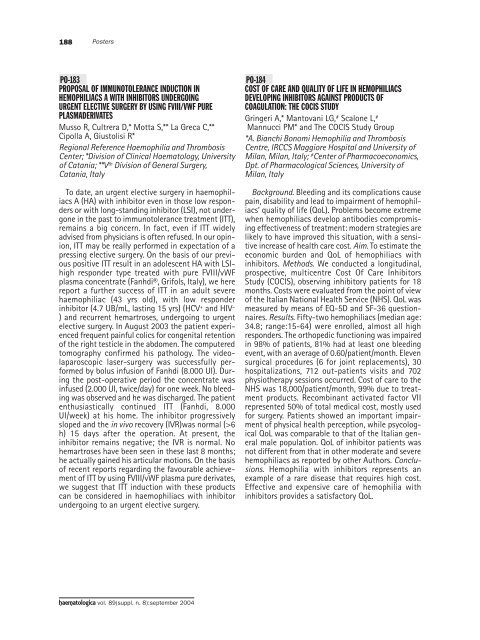Haematologica 2004;89: supplement no. 8 - Supplements ...
Haematologica 2004;89: supplement no. 8 - Supplements ...
Haematologica 2004;89: supplement no. 8 - Supplements ...
- No tags were found...
Create successful ePaper yourself
Turn your PDF publications into a flip-book with our unique Google optimized e-Paper software.
188PostersPO-183PROPOSAL OF IMMUNOTOLERANCE INDUCTION INHEMOPHILIACS A WITH INHIBITORS UNDERGOINGURGENT ELECTIVE SURGERY BY USING FVIII/VWF PUREPLASMADERIVATESMusso R, Cultrera D,* Motta S,** La Greca C,**Cipolla A, Giustolisi R*Regional Reference Haemophilia and ThrombosisCenter; *Division of Clinical Haematology, Universityof Catania; **V th Division of General Surgery,Catania, ItalyTo date, an urgent elective surgery in haemophiliacsA (HA) with inhibitor even in those low respondersor with long-standing inhibitor (LSI), <strong>no</strong>t undergonein the past to immu<strong>no</strong>tolerance treatment (ITT),remains a big concern. In fact, even if ITT widelyadvised from physicians is often refused. In our opinion,ITT may be really performed in expectation of apressing elective surgery. On the basis of our previouspositive ITT result in an adolescent HA with LSIhighresponder type treated with pure FVIII/vWFplasma concentrate (Fanhdi®, Grifols, Italy), we herereport a further success of ITT in an adult severehaemophiliac (43 yrs old), with low responderinhibitor (4.7 UB/mL, lasting 15 yrs) (HCV + and HIV −) and recurrent hemartroses, undergoing to urgentelective surgery. In August 2003 the patient experiencedfrequent painful colics for congenital retentio<strong>no</strong>f the right testicle in the abdomen. The computeredtomography confirmed his pathology. The videolaparoscopiclaser-surgery was successfully performedby bolus infusion of Fanhdi (8.000 UI). Duringthe post-operative period the concentrate wasinfused (2.000 UI, twice/day) for one week. No bleedingwas observed and he was discharged. The patiententhusiastically continued ITT (Fanhdi, 8.000UI/week) at his home. The inhibitor progressivelysloped and the in vivo recovery (IVR)was <strong>no</strong>rmal (>6h) 15 days after the operation. At present, theinhibitor remains negative; the IVR is <strong>no</strong>rmal. Nohemartroses have been seen in these last 8 months;he actually gained his articular motions. On the basisof recent reports regarding the favourable achievementof ITT by using FVIII/vWF plasma pure derivates,we suggest that ITT induction with these productscan be considered in haemophiliacs with inhibitorundergoing to an urgent elective surgery.PO-184COST OF CARE AND QUALITY OF LIFE IN HEMOPHILIACSDEVELOPING INHIBITORS AGAINST PRODUCTS OFCOAGULATION: THE COCIS STUDYGringeri A,* Mantovani LG, # Scalone L, #Mannucci PM* and The COCIS Study Group*A. Bianchi Bo<strong>no</strong>mi Hemophilia and ThrombosisCentre, IRCCS Maggiore Hospital and University ofMilan, Milan, Italy; # Center of Pharmacoeco<strong>no</strong>mics,Dpt. of Pharmacological Sciences, University ofMilan, ItalyBackground. Bleeding and its complications causepain, disability and lead to impairment of hemophiliacs’quality of life (QoL). Problems become extremewhen hemophiliacs develop antibodies compromisingeffectiveness of treatment: modern strategies arelikely to have improved this situation, with a sensitiveincrease of health care cost. Aim. To estimate theeco<strong>no</strong>mic burden and QoL of hemophiliacs withinhibitors. Methods. We conducted a longitudinal,prospective, multicentre Cost Of Care InhibitorsStudy (COCIS), observing inhibitory patients for 18months. Costs were evaluated from the point of viewof the Italian National Health Service (NHS). QoL wasmeasured by means of EQ-5D and SF-36 questionnaires.Results. Fifty-two hemophiliacs (median age:34.8; range:15-64) were enrolled, almost all highresponders. The orthopedic functioning was impairedin 98% of patients, 81% had at least one bleedingevent, with an average of 0.60/patient/month. Elevensurgical procedures (6 for joint replacements), 30hospitalizations, 712 out-patients visits and 702physiotherapy sessions occurred. Cost of care to theNHS was 18,000/patient/month, 99% due to treatmentproducts. Recombinant activated factor VIIrepresented 50% of total medical cost, mostly usedfor surgery. Patients showed an important impairmentof physical health perception, while psycologicalQoL was comparable to that of the Italian generalmale population. QoL of inhibitor patients was<strong>no</strong>t different from that in other moderate and severehemophiliacs as reported by other Authors. Conclusions.Hemophilia with inhibitors represents anexample of a rare disease that requires high cost.Effective and expensive care of hemophilia withinhibitors provides a satisfactory QoL.haematologica vol. <strong>89</strong>(suppl. n. 8):september <strong>2004</strong>
















